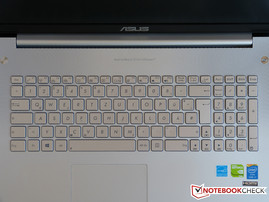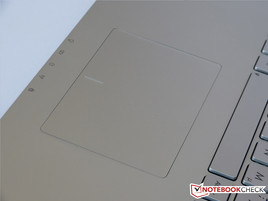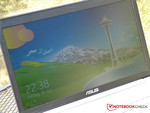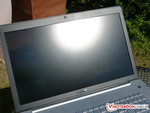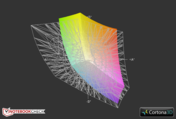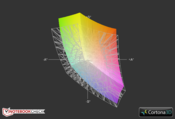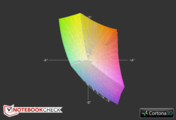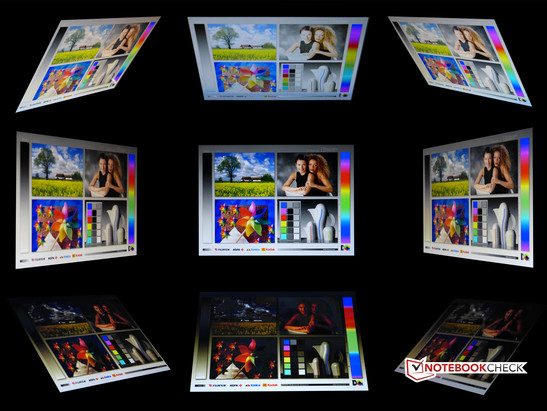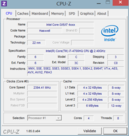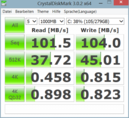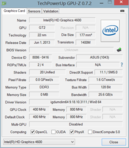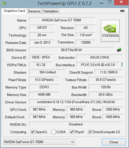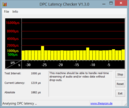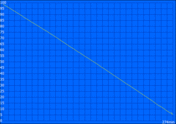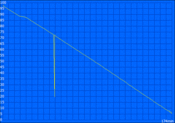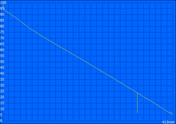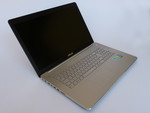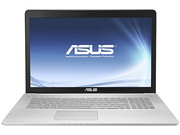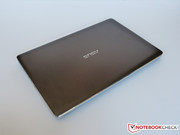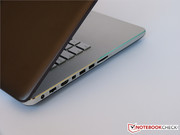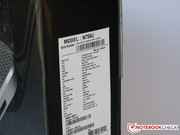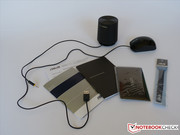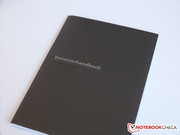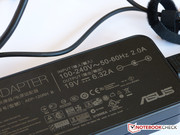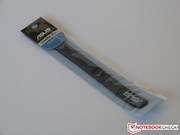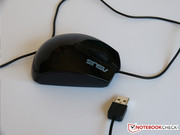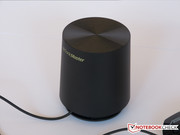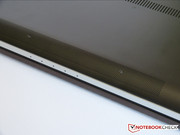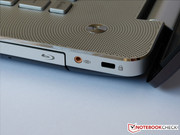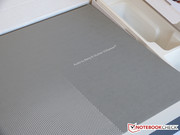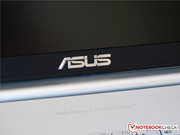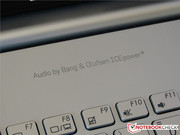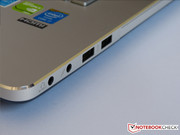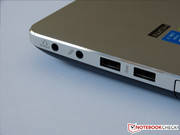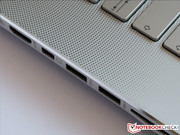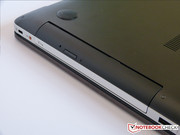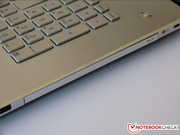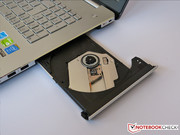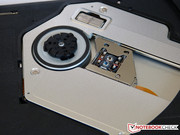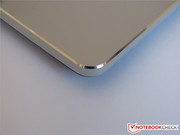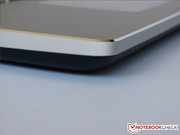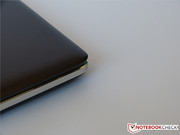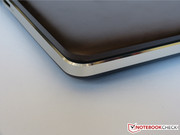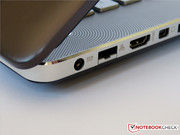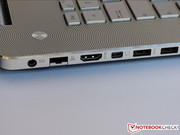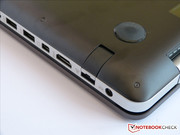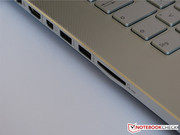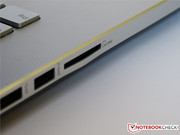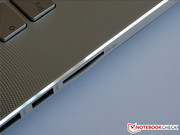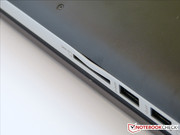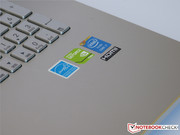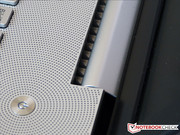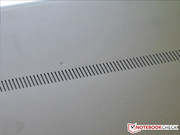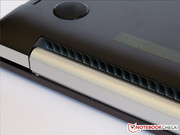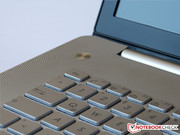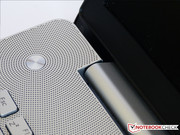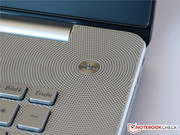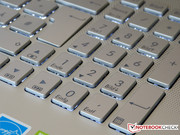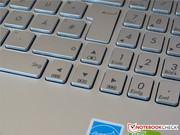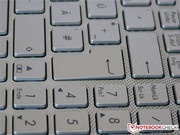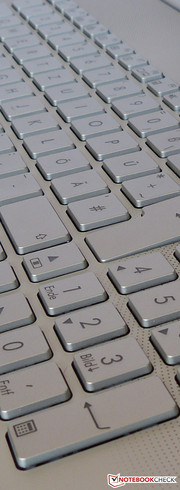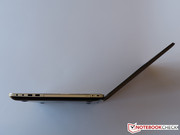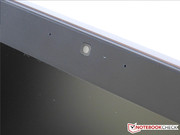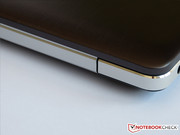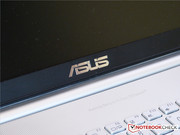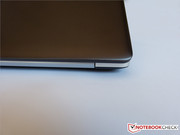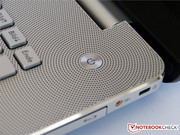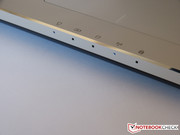Review Asus N750JV-T4110H Notebook

For the original German review, see here.
The N750JV's predecessor, the N76VZ, was a great device: The display, the keyboard, even the sound system - the vast majority of its components were well-chosen. In combination with its great build quality and its aluminum look, the Taiwanese multimedia workhorse was a sight to see.
Now, the Asus N750JV has been released, set to continue its predecessor's success story together with its smaller sibling, the 15-inch N550JV which we will review shortly. Both laptops come equipped with Haswell CPUs. Specifically, the N750JV sports a Core i7-4700HQ and an upper middle-class GPU, the GeForce GT 750M which should have no trouble handling even some of the more demanding applications and 3D games.
But the innovations don't end here: The chassis has been modified too. The exhaust vents have been relocated to the rear part of the device (instead of its left-hand side), and the keyboard now sports a silvery finish (the same color as the case) instead of a black one.
Changes concerning the chassis don't come without inherent dangers, especially when the cooling system is involved. After all, the Intel CPU comes with a TDP (thermal design power) of 47 watts which, in addition with the dedicated graphics card, leads to a lot of excess heat which has to be dissipated in order to prevent the case from reaching high temperatures. Whether this was a change for the better or the worse ("never change a running system"), our review will show.
The chassis of the N750JV is well-chosen. Not only are both the upper lid and the upper part of the base unit made from (anthracite-colored and silvery) aluminum, the rest of the case has a premium look and feel to it too, despite of the fact that it is made from plastic. Haptics and visual aesthetics are great and even its stability is fine: Applying pressure to the body only leads to slight deformations (mostly in the vicinity of the rear exhaust vents). Only the display and its lid could be more torsion-resistant. The display hinges are strong enough to keep the lid firmly in position, even in the car or on the train.
Build quality is great, at least on a first glance. The abraded edges, the use of aluminum, all of this corroborates the premium feel. There are some minor shortcomings though, such as a small (probably unintentional) plastic arch beneath the card reader which dampens our positive first impression a bit.
One "special feature" is the "Asus Console" button at the left, right above the keyboard. This "Asus Console" is a control panel for a number of settings and information about the system.
3.3 kilograms - that is neither heavy nor lightweight for a 17-inch device. It is, however, definitely nowhere close to the ultrabook-like feeling some of Asus' PR images suggest. Asus has taken great lengths at making the laptop appear slimmer than it actually is: For starters, the plastic underbelly begins right beneath the ports and it is painted in a dark hue so that the actual height of 2.9 centimeters doesn't really become that evident in photos of the device.
In contrast to its predecessor (where the fan sat on the left, a bad choice for left-handed users), the exhaust vents have been positioned at the rear of the device, right in front of the display hinge. Depending on the opening angle of the display, the hot air gets blown out behind or in front of the display. In both cases, this shouldn't be a problem during actual usage of the device as the user can't really feel this air flow while working with the device. The intake for cool air is located beneath the device where it can be opened by loosening 14 tiny screws.
Due to the exhaust vents being placed at the rear end of the device, all ports have moved to either the left or the right hand side. Both sides sport two USB 3.0 ports. On the left, these are accompanied by a 4-in-1 card reader, a MiniDP as well as an HDMI and an RJ45 Ethernet port and the power connector. Analog displays cannot be connected without an adapter which may or may not be a problem for some users (after all, most home cinema beamers come with an HDMI port).
On the right, the Blu-ray drive takes up most of the space next to the two USB 3.0 ports, the Kensington lock (at the rear end of the device) and three audio ports: Line In, Line Out and a subwoofer port, as the N750JV ships without an internal subwoofer, but with an external solution which can be connected to the laptop whenever it is needed. The headset audio jack supports SPIDF, thus being capable of digital audio output.
Thanks to the balanced placement of USB 3.0 ports neither left-handed nor right-handed users should have trouble connecting external devices to the laptop. Solely a display or beamer connected via HDMI to the left side of the N750JV might cause some problems for left-handers due to its large connector.
Communication
The N750JV ships with an Atheros Wi-Fi b/g/n and Bluetooth 4.0 chip as well as gigabit Ethernet via the Realtek RTL8168/8111. Signal strength is above-average, beating many other devices (Lenovo ThinkPad Edge E135, IdeaPad A1) and remaining usable (albeit getting slower) even when two concrete ceilings are placed in between the laptop and the router.
Accessories
At a first glance it already becomes evident that this is no cheap device. Not only the laptop plus power adapter, but also an external subwoofer and an external USB mouse are part of the package. In addition, the device ships with a user manual, a driver DVD, the warranty information (plus a warranty card) and a zip tie.
Maintenance
The maintenance hatch beneath the laptop can be opened by removing 14 tiny Torx screws. This reveals access to the battery, the two hard drives and the RAM module. In addition, the CPU and GPU fans can now be cleaned.
Warranty
The Asus N750JV ships with 24 months of a "pick up & return" warranty. At the time of writing, we have no information about possible warranty extensions since they are not yet listed on Asus' website.
Keyboard
Asus equips the N750JV with its proven chiclet-style keyboard which comes with a clear pressure point and somewhat short key travel. Build quality wasn't as good as expected, which may partly be due to the skewed return key. The keyboard includes an amply-sized numpad, but the arrow keys are a bit crowded. No unnecessary special keys are equipped. Instead, as with many other laptops pressing "Fn" plus "F1" to "F12" allows the user to change some settings such as the display brightness.
A special feature is the white keyboard backlighting which comes with three steps (33%, 66%, 100%), which can be increased and decreased via "Fn+F4" and "Fn+F3".
Touchpad
The touchpad has been slightly improved when compared to the predecessor of the N750JV. Tapping the touchpad lightly is now sufficient to register as a click, removing the need for pressing strongly. Still, the upper right corner of the touchpad offers a lot more resistance to clicks than the rest of the touchpad. Presses in the lower right corner lead to a feeling as if the touchpad jams slightly (maybe due to some overlap with the base unit or another component of the laptop), leading to a less satisfying (right) clicking noise.
The differences in resistance when trying to click are not as bad as the "impure" sound of right clicks. In addition to this flaw, the touchpad cannot be used in close vicinity to its borders (the last 3-4 millimeters don't react at all). At the same time, the cursor can be moved in the "mouse click area" as well, leading to an obscured borderline between the two.
Still, the touchpad is rather well-suited during actual usage. Most of these shortcomings (except for the one about the right clicks) are not that relevant as firm presses on the touchpad become too strenuous over time no matter what.
Such a pricy multimedia laptop cannot really work without a Full HD display. Accordingly, the N750JV ships with a matte 1920x1080 panel made by AU Optronics. With this, movies and videos do not only appear sharp, but also come without any annoying reflections. The latter is not only important when used indoors, as its display brightness of up to 320 cd/m² should be enough to use the device on the back porch as well - as long as direct sunlight can be avoided. For comparison: While the 15-inch One K56-3F comes equipped with very similar innards and a display brightness of 328 cd/m² (20 cd/m² more on average), it is barely suited for outdoor usage due to its glossy, reflective display. Another competitor, the Ivy Bridge-based (but ATI-powered) Samsung Series 7 Chronos 770Z7E only manages to reach 253 cd/m² on average.
Brightness homogeneity levels of around 85% are okay for a multimedia notebook (not being noticeable with the naked eye), but they could be better. The One reaches 87%. However, Samsung's device doesn't exceed 79%.
| |||||||||||||||||||||||||
Brightness Distribution: 85 %
Contrast: 637:1 (Black: 0.52 cd/m²)
ΔE Color 3.41 | 0.5-29.43 Ø5
ΔE Greyscale 3.1 | 0.57-98 Ø5.3
Gamma: 2.53
Both in terms of its black levels and its contrast ratio, the N750JV is on par with its main competitors, ending up slightly behind those of the Samsung Chronos Series 7 770Z7E while staying ahead of the One K56-3F. All three laptops are perfectly suited for all multimedia applications, a result which gets proven during actual usage.
Color space rendition is another topic, albeit one which is only of particular interest to professional graphics artists. The display of the N750JV stays true to that of its predecessor, failing to reach either the AdobeRGB or the sRGB color space. When comparing the latter to the color rendition of our test device, a slight yellowish-greenish tint can be discerned. Then again, a DeltaE value of just 3.41 (as measured via CalMAN) signifies that this color deviation is barely noticeable. Some parts of the grayscale measurements showed a tiny bluish distortion, but again, this is too weak to be seen with the naked eye.
The viewing angles are great, even at extreme angles no color inversion occurs in any direction - with the unfortunate exception of looking at the display from below. In this case (which rarely becomes relevant when using the notebook on one's lap), color inversion begins at an angle of approximately 45 degrees.
The Asus N750JV comes equipped with an Intel Core i7-4700HQ, an Nvidia GeForce GT 750M and 8 GB of DDR3 RAM - which should be enough for all possible multimedia usage scenarios, and even sufficient for many modern PC games and demanding software applications. As the Core i7-4700HQ is a Haswell CPU, we explicitly compare this to the most modern Ivy Bridge CPU, the Intel Core i7-3635QM which has been used in some of the N750JV's competitors such as the Samsung Series 7 Chronos 770Z7E. We will also compare the N750JV to the One K56-3F as it sports similar hardware (Intel Core i7-4700MQ, also a GeForce GT 750M).
Processor
The Intel Core i7-4700HQ is a Haswell-based middle-class CPU supporting not only hyper-threading (which simulates another four virtual cores) but also Intel's Turbo Boost mode which is capable of increasing the base clock speed of 2.4 GHz to up to 3.4 GHz (during single-core usage) if need be. More information about this CPU can be found in our FAQ section.
As the CPU has only recently entered the market, few benchmarks results are already available. Two entries exist in our database, thanks to the Asus G750JX and the Asus G750JW (which only differ in terms of RAM and GPU) which sport the same processor. Our test device falls behind these two in nearly all benchmarks, e.g. with 6567 points during 3DMark06 (where the others reached 6883 and 6901 points). The two G750 devices always ended up being on par, with the only exception being the single-core benchmark of Cinebench R10 64-bit (N750JV: 6008, G750JX: 6302, G750JW: 6612), but even here, our test device took the last spot.
This leads us to suspect that the Intel Core i7-4700HQ is incapable of accessing its full Turbo Boost potential, which is why we also compare it to the Intel Core i7-4700MQ (which comes with the exact same CPU but a different integrated GPU when compared to the HQ version).
Still, the same picture holds true as above. With the exception of the Cinebench R11.5 single-core benchmark and the Lenovo IdeaPad Y510p, the N750JV offers weaker performance than all of its competitors.
Analyzing the CPU performance leads to the crucial clue: Even during the single-core benchmarks of Cinebench R10 and R11.5, the maximum Turbo Boost can only be upheld for less than a second, going down to 3.3 GHz almost immediately, where it stays. This leads to 9% and 4% worse results than for the G750JW and the G750JX during Cinebench R10. During the Torture Test of Prime 95, their cores also throttle down to 2.6 GHz, but sometimes go up again to 2.8 GHz (for approx. half a second).
| Cinebench R11.5 | |
| CPU Multi 64Bit (sort by value) | |
| Asus N750JV-T4110H | |
| Lenovo IdeaPad Y510p | |
| SCHENKER XMG A523 | |
| Asus N76VZ-V2G-T1011V | |
| CPU Single 64Bit (sort by value) | |
| Asus N750JV-T4110H | |
| Lenovo IdeaPad Y510p | |
| SCHENKER XMG A523 | |
| Cinebench R10 | |
| Rendering Multiple CPUs 64Bit (sort by value) | |
| Asus N750JV-T4110H | |
| Lenovo IdeaPad Y510p | |
| SCHENKER XMG A523 | |
| Asus N76VZ-V2G-T1011V | |
| Rendering Single CPUs 64Bit (sort by value) | |
| Asus N750JV-T4110H | |
| Lenovo IdeaPad Y510p | |
| SCHENKER XMG A523 | |
| Asus N76VZ-V2G-T1011V | |
| 3DMark 06 - CPU - CPU Score (sort by value) | |
| Asus N750JV-T4110H | |
| Lenovo IdeaPad Y510p | |
| SCHENKER XMG A523 | |
| Asus N76VZ-V2G-T1011V | |
System Performance
The overall system performance is measured via PCMark 7. The 3211 points of the N750JV is much better than the result of its predecessor (2469), but approximately 500 points less than what the Samsung 700Z7E achieves due to its more powerful GPU. Thanks to its SSD, which is an important factor during PCMark benchmarks, the One K56-3F (which sports the exact same hardware as the N750JV) yields a phenomenal result of 5905 points. Thus, the System Storage benchmark results in 5524 points in the case of the One K56-3F, much more than the 1417 and 2281 points of the N750JV and the Samsung 700Z7E. The same overall picture holds true for the Entertainment score, where the competitors pull clear by around 35%.
| PCMark 7 Score | 3211 points | |
Help | ||
Storage Devices
A difference of 700 points during the PCMark 7 System Storage benchmark is hard to explain, especially since the N750JV ships with Seagate Momentus 5400 rpm HDDs which are comparable to those used in the Samsung laptop. Actually, the average transfer speeds of around 85.3 MB/s (as measured with HD Tune) are even a bit better than those of the Samsung 770Z7E (83.3 MB/s), as are the access times (17.1 milliseconds vs. 19.2 milliseconds).
Thus, the HDD variant used in the N750JV is actually an upper middle-class variant, as confirmed with the CrystalDiskMark benchmark. The culprit might be the strange partitioning of the two HDDs into four partitions with 280 GB, 2x 350 GB and 400 GB instead of just leaving them at 2x 750 GB.
Graphics Card
The Asus N750JV comes equipped with a GeForce GT 750M with 4096 MB of DDR3 RAM manufactured by Nvidia. The GPU supports both PhysX and Nvidia Optimus which allows the card to be completely deactivated (e.g. in desktop mode) in order to save energy, by relying on the integrated Intel HD Graphics 4600 of the Core i7-4700HQ instead. The GeForce GT 750M comes with a base clock speed of 967 MHz and a maximum GPU Boost 2.0 clock speed of 1050 MHz. In our benchmarks and specifically during our stress test, up to 1162.7 MHz was reached.
The One K56-3F is the only other notebook with a GT 750M in our database. AMD's equivalent GPU is supposed to be the HD 8850M, but no benchmarks exist at the time of writing. That is why we will compare the N750JV to the One K56-3F and Samsung's 770Z7E which comes with the more powerful HD 8870M.
The N750JV falls behind its competition in nearly all 3DMark benchmarks, although the distance to the One K56-3F is never more than a few percent, except for the physics benchmarks of 3DMark Vantage, 3DMark 11 and the Cloud Gate benchmark, where it takes the lead by about 20%. The 770Z7E with its more powerful AMD graphics card is approximately 20% faster than the N750JV in all regards. We have actually deactivated PhysX during the 3DMark Vantage benchmark, leading to a higher CPU load, which may be another indication for CPU-based throttling issues.
Unfortunately, throttling does not only occur during our stress test, but also while running on battery power: Then, the results of 3DMark06 fall from 13820 points to a mere 8518 points.
| 3DMark 06 - 1280x1024 Standard Score AA:0x AF:0x (sort by value) | |
| Asus N750JV-T4110H | |
| Asus N76VZ-V2G-T1011V | |
| 3DMark Vantage - 1280x1024 P Result (sort by value) | |
| Asus N750JV-T4110H | |
| Asus N76VZ-V2G-T1011V | |
| 3DMark 11 | |
| 1280x720 Performance (sort by value) | |
| Asus N750JV-T4110H | |
| Asus N76VZ-V2G-T1011V | |
| 1280x720 Performance Physics (sort by value) | |
| Asus N750JV-T4110H | |
| Asus N76VZ-V2G-T1011V | |
| 3DMark 06 Standard Score | 13820 points | |
| 3DMark Vantage P Result | 9618 points | |
| 3DMark 11 Performance | 2735 points | |
| 3DMark Ice Storm Standard Score | 70024 points | |
| 3DMark Cloud Gate Standard Score | 8871 points | |
| 3DMark Fire Strike Score | 1508 points | |
Help | ||
Gaming Performance
Again, we are comparing the Asus N750JV with the competitors made by One and Samsung. and again, it falls behind in the gaming benchmarks by approximately 5 to 10% when compared to the One K56-3F and up to 20% when looking at the Samsung Series 7 Chronos 770Z7E instead.
Unfortunately, the N750JV comes with one unusual shortcoming: When repeating the benchmarks again and again, the resulting frame rates became worse, leading to a gradual decline in performance when the CPU and GPU weren't given any time to recover. In Counter-Strike: Global Offensive, we only reached 44.6 and 41 fps instead of 58.5 and 51.2 fps (high / very high graphics quality) and in F1: 2012, performance levels even fell from 87 fps to 46 fps.
Thus, we have tried to reproduce this behavior during actual gaming tests. During the Skyrim benchmark, we measured 31.3 fps. Afterwards, we spent 20 minutes in the single-player RPG. Skyrim ran with approximately 76.3 fps on high settings, making it perfectly playable. Luckily, the suspected strong decline in performance could not be observed. The same holds true for the decline in gaming performance while running on battery (8518 points instead of 13820 points in 3DMark06): When we tested this in Metro: Last Light, we only lost 1 fps (high graphics quality).
Thanks to its GeForce GT 750M, the N750JV is well-suited even for modern 3D games running on medium to high settings. It is not that important that the N750JV is not quite as fast as the One K56-3F - usually, it is still more than fast enough to render almost all games without resorting to desperate measurements like setting everything to "low".
| The Elder Scrolls V: Skyrim | |
| 1366x768 Medium Preset AA:4x (sort by value) | |
| Asus N750JV-T4110H | |
| Samsung 770Z7E-S01DE | |
| One K56-3F | |
| 1366x768 High Preset AA:8x AF:8x (sort by value) | |
| Asus N750JV-T4110H | |
| Samsung 770Z7E-S01DE | |
| One K56-3F | |
| 1920x1080 Ultra Preset AA:8x AF:16x (sort by value) | |
| Asus N750JV-T4110H | |
| Samsung 770Z7E-S01DE | |
| One K56-3F | |
| F1 2012 | |
| 1366x768 Medium Preset (sort by value) | |
| Asus N750JV-T4110H | |
| One K56-3F | |
| 1366x768 High Preset AA:2xMS (sort by value) | |
| Asus N750JV-T4110H | |
| One K56-3F | |
| 1920x1080 Ultra Preset AA:4xMS (sort by value) | |
| Asus N750JV-T4110H | |
| One K56-3F | |
| Counter-Strike: GO | |
| 1366x768 High AA:2x MS AF:4x (sort by value) | |
| Asus N750JV-T4110H | |
| Samsung 770Z7E-S01DE | |
| One K56-3F | |
| 1920x1080 (Very) High, FXAA AA:4x MS AF:8x (sort by value) | |
| Asus N750JV-T4110H | |
| Samsung 770Z7E-S01DE | |
| One K56-3F | |
| Tomb Raider | |
| 1366x768 High Preset AA:FX AF:8x (sort by value) | |
| Asus N750JV-T4110H | |
| Samsung 770Z7E-S01DE | |
| One K56-3F | |
| 1920x1080 Ultra Preset AA:FX AF:16x (sort by value) | |
| Asus N750JV-T4110H | |
| Samsung 770Z7E-S01DE | |
| One K56-3F | |
| Metro: Last Light | |
| 1024x768 Low (DX10) AF:4x (sort by value) | |
| Asus N750JV-T4110H | |
| One K56-3F | |
| 1366x768 Medium (DX10) AF:4x (sort by value) | |
| Asus N750JV-T4110H | |
| One K56-3F | |
| 1366x768 High (DX11) AF:16x (sort by value) | |
| Asus N750JV-T4110H | |
| One K56-3F | |
| 1920x1080 Very High (DX11) AF:16x (sort by value) | |
| Asus N750JV-T4110H | |
| One K56-3F | |
| low | med. | high | ultra | |
| The Elder Scrolls V: Skyrim (2011) | 49.2 | 31.3 | 19.9 | |
| Counter-Strike: GO (2012) | 95 | 58.5 | 51.2 | |
| F1 2012 (2012) | 87 | 77 | 33 | |
| Tomb Raider (2013) | 40.2 | 17.9 | ||
| Metro: Last Light (2013) | 44.5 | 36.1 | 20.4 | 8.9 |
System Noise
The fan of our test device remained rather silent during most usage scenarios, becoming audible (38.7 dB(A)) but not annoyingly so under full load and during our stress test. The optical drive was a bit louder than the fan during Blu-ray playback, but not loud enough to prevent us from enjoying the movie. While idle, the fan doesn't become completely quiet, staying at 33.1 dB(A).
Noise Level
| Idle |
| 33.1 / 33.4 / 33.6 dB(A) |
| HDD |
| 33.7 dB(A) |
| DVD |
| 35.6 / dB(A) |
| Load |
| 38.7 / 43 dB(A) |
 | ||
30 dB silent 40 dB(A) audible 50 dB(A) loud |
||
min: | ||
Temperature
While our test device remained rather cool while idle (up to 28.1 °C), it became a lot hotter during the stress tests (up to 46 °C). The maximum temperature was measured on the upper rear part of the base unit, right in front of the display above the exhaust vents. The keyboard also becomes noticeably warmer in this scenario, reaching 41.2 °C. Then again, both the Samsung notebook and the laptop made by One get as hot or even hotter than the N750JV.
It only took the CPU cores less than one minute of activity during our stress test to reach up to 98 °C which leads to imminent throttling down to 2.4 GHz and later even down to 800 MHz where it remains for a number of minutes, resulting in a final temperature of around 60 °C. At least these throttling issues under extreme stress do not occur in the case of the GPU which always remains clocked at 1162 MHz.
(-) The maximum temperature on the upper side is 46 °C / 115 F, compared to the average of 36.9 °C / 98 F, ranging from 21.1 to 71 °C for the class Multimedia.
(±) The bottom heats up to a maximum of 41.8 °C / 107 F, compared to the average of 39.1 °C / 102 F
(+) In idle usage, the average temperature for the upper side is 25.5 °C / 78 F, compared to the device average of 31.2 °C / 88 F.
(+) The palmrests and touchpad are cooler than skin temperature with a maximum of 28.5 °C / 83.3 F and are therefore cool to the touch.
(±) The average temperature of the palmrest area of similar devices was 28.8 °C / 83.8 F (+0.3 °C / 0.5 F).
Speakers
Any great multimedia laptop needs great speakers. Asus promises quite a lot with its "Audio by Bang & Olufsen ICEPower" overprint - and it actually holds this promise: Everything sounds natural, both the highs and the mids are rendered harmoniously. Bass only becomes noticeable when the external subwoofer is plugged in. The only flaw of the sound system is its location right beneath the front of the laptop. Although this is just a minor complaint, direct sound exposure without first getting reflected by the table would have been preferable.
Power Consumption
Not much can be said about the power consumption of the Asus N750JV: When Wi-Fi is deactivated, brightness is set to minimum and the energy saving mode is activated, the laptop merely requires 9.7 watts. While idle, but with maximum brightness and the "maximum performance" profile, this goes up to 18.6 watts. The maximum we measured was 94.7 watts - quickly decreasing to 76.6 watts during our stress test due to its throttling issues. These are actually decent values for a multimedia laptop with such potent hardware components. The One K56-3F reaches 83.3 / 138.1 watts, the Samsung Series 7 Chronos 770Z7E requires up to 75.7 / 91.7 watts.
| Off / Standby | |
| Idle | |
| Load |
|
Battery Life
The battery of the N750JV is actually a little bit smaller than that of its competitors, sporting 70 watt hours. Both its predecessor and the Samsung laptop sport batteries with 80 Wh while the 62.5 Wh of the One K56-3F is not really comparable as it is just a 15-inch device.
Still, the N750JV offers more than decent battery life. 4:34 h of browsing (Samsung: 5:08 h, N76VZ: 3:42 h, K56-3F: 4:20 h) and 2:54 h of Blu-ray playback (Samsung: 2:42 h, N76VZ: 3:09 h, K56-3F: 3:16 h) are on par with the competition.
We were surprised by the great battery runtime while idle: 6:53 h is more than what any of the competitors offer. 0:57 h under full load is on par with most other devices, with the only exception being the One K56-3F (1:53 h). Thus, neither browsing the web nor enjoying a great movie should limit the N750JV's mobility.
Verdict
One thing is certain: The Asus N750JV was never intended to be a cheap multimedia laptop. Still, its price point of around $1300 feels adequate. After all, the device sports a great display and an aluminum chassis while shipping with a number of accessories. Specs are fine too: A Haswell CPU, an upper middle-class graphics card and 1.5 TB of hard drive space should be more than enough for most multimedia applications.
During mobile usage, the N750JV offers decent battery life, sufficient even for longer movies. Gaming performance is fine as well, although those attracted towards more GPU power might want to have a look at some proper gaming laptops if they can live with their bulkier cases: The One K56-3F, the Medion Erazer X7825 and the Asus G750JW might all be viable alternatives, with some of them actually offering better connectivity and better specs for the same price. Some competing multimedia laptops are the Haswell variants of the Schenker XMG A723, the MSI GE70-i760M287B and the Acer Aspire V3-772G.
Still, the Asus N750JW remains a more than decent choice, despite minor flaws such as the build quality beneath the SD card reader slot and the haptics of the input devices. Apart from these issues, the N750JW is a silent, universally usable multimedia laptop with a great display and fine speakers.


 Deutsch
Deutsch English
English Español
Español Français
Français Italiano
Italiano Nederlands
Nederlands Polski
Polski Português
Português Русский
Русский Türkçe
Türkçe Svenska
Svenska Chinese
Chinese Magyar
Magyar


